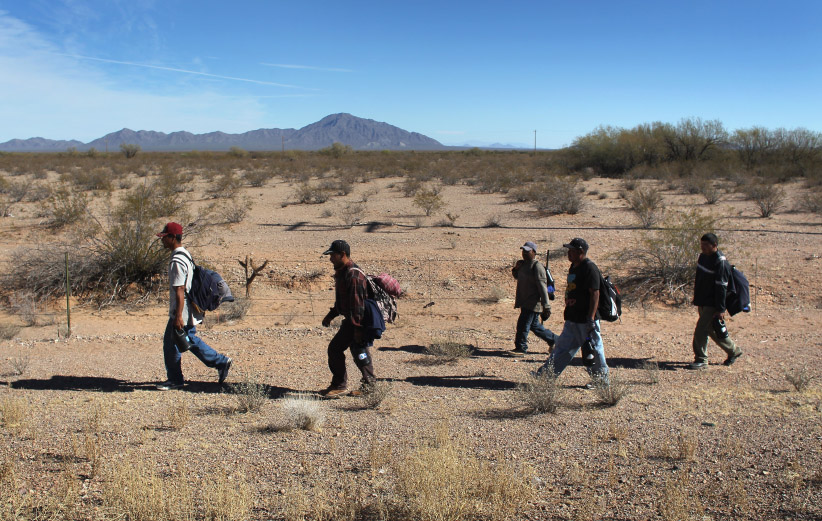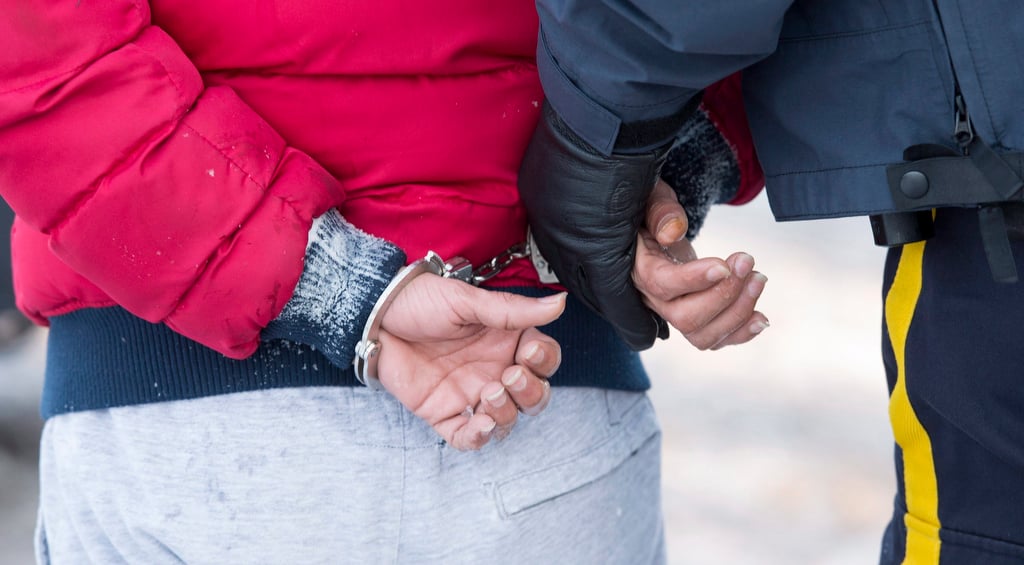The safe third country pact imperils lives—just like a border wall
Marcello Di Cintio has seen border-hoppers risking their lives in desolate country before—in the deserts north of Mexico
Undocumented Mexican immigrants walk through the Sonoran Desert after illegally crossing the U.S.-Mexico border border on January 19, 2011 into the Tohono O’odham Nation, Arizona. The immigrants said they had wandered the desert lost for a week after crossing from Mexico into the vast Indian reservation at night. Exhausted, they requested the Border Patrol to pick them up and take them to the U.S.-Mexico border, from where they would return to their homes in the Mexican state of Sonora. They had come, they said, to reach Phoenix and find work in construction or landscaping. All said they had worked in Arizona before. (John Moore/Getty Images)
Share

In 2016, 160 sets of human remains were recovered from the southern Arizona wildlands along the U.S.-Mexico border. This is less than average. The Pima County medical examiner’s office usually finds about 170 bodies each year and has recovered the remains of more than 2,500 “UBCs”—undocumented border crossers—since 2001. The numbers may be shocking, but many observers believe the U.S.-Mexico border was, in fact, designed to kill people. Dead migrants form part of a long-standing American border policy based on “prevention through deterrence.” A 1994 strategic plan called for erecting walls near the larger border towns where migrants could easily “assimilate with the population” once they’d crossed over. Walling off the urban areas would funnel migrants into “remote, uninhabited expanses of land,” the plan said, where they could find themselves in “mortal danger.” This danger was meant to deter migrants from trying to cross the border in the first place.
The plan didn’t work. The walls that rose near the border towns of Nogales, Douglas, and Sasabe left the Sonoran Desert as Arizona’s only open door into America. The most desperate migrants took their chances, and the most unlucky of them died of thirst or exposure amid the dust and mesquite. Since the border patrol implemented the 1994 strategy, more than 6,000 bodies have been recovered from the entire length of the U.S.-Mexico line. American policy had transformed the crime of “illegal entry” into an offence that, for many, proved punishable by death.
So goes the grim, cautionary tale the Arizona borderlands have to tell Canadians, at a time when refugees are fleeing north from Donald Trump’s United States. Just as American border strategy drives southern migrants into the more porous desert, the safe third country agreement compels refugees fearing deportation from America to sneak into Canada. The 2004 agreement mandates Canadian border control officials to turn away refugee claimants arriving from the U.S. to seek asylum in Canada, and vice versa. Yet Canadian law entitles anyone who manages to circumvent the border posts the right to apply for refugee status. Hence the illicit crossings. The safe third country pact may lack the cinematic drama of a border wall. But the policy likewise coaxes refugees across unguarded stretches of Canadian borderline.
READ MORE: The new underground railroad to Canada
The northern and southern borderlands now also share a cottage industry of human smuggling. Both the Border Patrol Strategic Plan and the safe third country agreement led to the rise of opportunistic agents willing to shuttle refugees and migrants to, or across, the border. Smugglers in the south, called coyotes, charge Mexican migrants between $1,200 and $3,500 per person for guided passage through the desert beyond the unbarricaded border. Coyotes charge more for children since they are considered more precious cargo, but clients from elsewhere in Central America pay the most. These migrants—known as OTMs, or “Other Than Mexicans,” in the degrading lexicon of the borderlands—pay up to ten times what Mexicans do.
The specifics of the safe third country agreement, combined with the Trump administration’s apparent distaste for refugees, has inspired a less sophisticated but parallel industry of northern coyotes. Refugees report paying New York City smugglers $1,000 per person to drive them to the border town of Plattsburgh, N.Y. Once there, they’ve been shelling out upwards of $300 each to unscrupulous local taxi or Uber drivers for the 35-minute ride the rest of the way to the Quebec border. Similarly, drivers in North Dakota charge refugees between $400 and $500 for trips to unpatrolled sections of the Manitoba line.

Hardening the border with more RCMP officers and border agents, as some suggest, would only raise the price of the smugglers’ services—another lesson from the U.S.-Mexico line. The more difficult the crossing becomes, the more smugglers charge. Hiring a coyote to help scale the wall between Tijuana and California, for example, used to cost $4,000. After the U.S. government replaced the old wall, built with recycled helicopter landing mats from the first Gulf War, with a new fifteen foot steel barrier, coyotes raised the price to $10,000. Migrants either paid the increased rates or found a cheaper—and usually more perilous—route across. A thicker U.S.-Canada border would only thicken the wallets of those willing to exploit desperate refugees.
READ MORE: This is Canada’s real refugee problem
The risk faced by asylum seekers on the Canadian border has yet to be measured in dead bodies, but these refugees face strikingly similar dangers as their southern counterparts. Winter nights along the U.S.-Canadian border can drop below -40°C, freezing unprepared and underdressed refugees. Migrants on the southern border face the opposite danger. In the Arizona desert, migrants brave summer temperatures that often hit 48°C, while nights can drop below freezing. Such temperature extremes, combined with dehydration, cause most migrant deaths—especially when the winter monsoons come late, as they did in 2009. Some coyotes exacerbate the environmental hazards by plying their slow and weary clients with energy drinks. The intake of sugar and caffeine can cripple bodies already weakened by days walking in the desert. Empty Red Bull cans litter the migrant trails throughout the Sonoran Desert.
To be clear, the intentions behind the relevant government policies in these two cases are starkly different. The U.S. designed a border strategy that deliberately pushes migrants into the desert. Canada signed a pact to curb “country shopping” on the part of claimants who’d already landed in a safe haven—the increased numbers of refugees crossing into this country since Trump was elected is an unintended by-product of the deal. The scale of the problem differs, too. Tens of thousands of migrants cross from Mexico into the U.S. each year while only a few hundred prospective refugees traverse the border into Canada. And Mexican coyotes widely outnumber their taxi-driving brethren up north.
Still, the outcome is starting to look eerily similar, and with no words of welcome expected out of Washington soon, the number of border-crossers continues to rise. The coming spring weather will further increase the traffic—and trafficking—of refugees across the U.S.-Canada line. While a few frostbitten fingers cannot compare to hundreds of corpses in the Sonoran Desert, some Manitoba farmers quietly dread what they might find in their fields once the snow melts.
Marcello Di Cintio lives in Calgary. His last book, Walls: Travels Along the Barricades, investigated life in the shadows of the world’s border walls and won the Shaughnessy Cohen Prize for Political Writing.